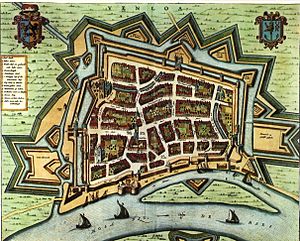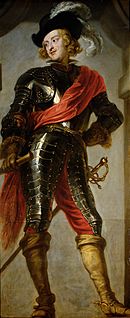Siege of Venlo (1637) facts for kids
Quick facts for kids Siege of Venlo |
|||||||
|---|---|---|---|---|---|---|---|
| Part of the Eighty Years' War | |||||||
 Map of Venlo in 1652, by Joan Blaeu. |
|||||||
|
|||||||
| Belligerents | |||||||
| Commanders and leaders | |||||||
| Cardinal-Infante Ferdinand | Nicolaas van Brederode | ||||||
| Strength | |||||||
| 17,000 soldiers | 1,200 soldiers Unknown number of burghers |
||||||
| Casualties and losses | |||||||
| Minor | 1,200 (mostly prisoners) | ||||||
The Siege of Venlo was a short but important battle during the Eighty Years' War. It happened from August 20 to 25, 1637. During this time, Cardinal-Infante Ferdinand of Austria, who was the Governor of the Spanish Netherlands, took back the city of Venlo. The United Provinces (which is now the Netherlands) had captured Venlo in 1632.
Taking Venlo, and then Roermond a week later, was a big win for Spain. It helped them cut off the city of Maastricht from the Dutch Republic. This made it harder for the Dutch to attack the Spanish Netherlands from the east.
Why the Siege Happened
The Eighty Years' War was a long fight between Spain and the Dutch Republic. In 1636, Spain decided to play defense in the Dutch areas. They wanted to focus on fighting France instead.
However, in July 1637, the Dutch leader, Frederick Henry, Prince of Orange, saw a chance to attack. He led an army of 18,000 soldiers to besiege (surround and attack) the city of Breda. The Dutch started digging long trenches around Breda to cut it off.
Cardinal-Infante Ferdinand, the Spanish leader, arrived with his army near Breda. He realized he couldn't easily help the city. So, he decided to attack the Dutch in a different area, the Maas valley. This was a way to try and make the Dutch stop their attack on Breda.
The Attack on Venlo

Ferdinand moved his army towards the Maas river. He sent some of his soldiers ahead to Venlo. The city's leader, Nicolaas van Brederode, knew they were coming. He had about 1,000 to 1,200 soldiers.
Van Brederode felt he didn't have enough soldiers to defend the whole city. So, he told his troops to guard the main gates and walls. He asked the citizens of Venlo to help defend the rest of the city.
When Ferdinand arrived, he split his large army into four groups. Each group set up camp around Venlo. They started digging trenches closer to the city walls. They also built batteries with five cannons each. These cannons began firing non-stop at Venlo.
At first, the city's defenders fired back. But as the Spanish got closer and their cannonballs started setting parts of the town on fire, the citizens became worried. They went to the city leaders and demanded that they ask for a stop to the fighting. Women even climbed the walls, begging the Spanish for mercy.
Seeing this, Van Brederode decided to send a drummer to talk with Cardinal-Infante Ferdinand. He wanted to discuss surrendering the city.
What Happened Next
Cardinal-Infante Ferdinand was surprised by how quickly Venlo surrendered. He left some soldiers in the city and kept moving his army. Just a week later, his cavalry quickly surrounded Roermond. After more heavy cannon fire, Roermond's defenders also gave up. About 1,100 Dutch soldiers left Roermond.
Ferdinand thought about attacking other Dutch cities like Grave or Maastricht. But his commanders advised him to stop. French armies were advancing in the south, which worried him.
Even though Ferdinand stopped his attack, taking Venlo and Roermond was a big victory for Spain. It made the people in the Southern Netherlands very happy. It also helped Spain cut off Maastricht from the rest of the Dutch Republic.
However, the Dutch leader Frederick Henry did not give up his siege of Breda. Despite losing Venlo and Roermond, Breda finally surrendered to him on October 11. Losing Breda was a big blow to King Philip IV of Spain. Breda was a symbol of Spain's power in Europe.
Images for kids
See also
 In Spanish: Sitio de Venlo (1637) para niños
In Spanish: Sitio de Venlo (1637) para niños


